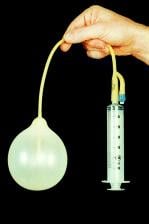
Problem being addressed[edit | edit source]
When a mother has a difficult delivery, she may risk suffering from complications such as postpartum hemorrhage due to acute postpartum uterine inversion, uterine atony, or placenta accreta. These issues cause major bleeding problems, which may require surgery or a hysterectomy. In developing countries especially rural areas, access to emergency medical care during these complications may be limited.
Detailed description of the solution[edit | edit source]
The Rusch balloon is a urinary balloon catheter that was originally used to treat urinary ailments. This device can be used during postpartum hemorrhage to stop the bleeding of inside the uterus. The inflation of the balloon applies pressure to the uterine wall, which helps to clot the blood. The balloon is inflated to the pressure of a Foley catheter and left for 24 hours.
Designed by[edit | edit source]
- Designed by: Heinz Rusch, from Germany
- Manufacturer (if different): Willy Rusch GMBH & Co. KG
References[edit | edit source]
Peer-reviewed publication[edit | edit source]
Johanson, R., Kumar, M., Obrhrai, M., & Young, P. (2001). Management of massive postpartum haemorrhage: use of a hydrostatic balloon catheter to avoid laparotomy. British Journal of Obstetrics and Gynaecology, 108, 420-422.
Keriakos, R., & Chaudhuri, S. R. (2011). Managing Major Postpartum Haemorrhage following Acute Uterine Inversion with Rusch Balloon Catheter. Case Reports in Critical Care, 2011. Retrieved October 21, 2012. Link available here.
Keriakos, R., & Mukhopadhyay, A. (2006). The use of the Rusch balloon for management of severe postpartum haemorrhage. J Obstet Gynaecol., 26(4), 335-8.
IP and copyright[edit | edit source]
The initial patent for a catheter with a balloon was issued May 5, 1981 and the Patent Number was US4265848. International classification: B29H 2104. The link to the patent can be found here. There have been many updates, improvement and patents that have stemmed from this invention.